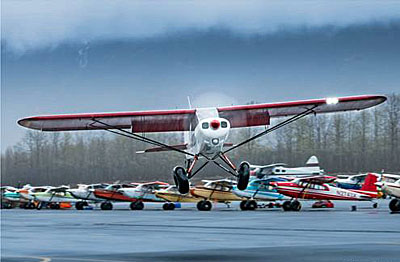
Beringer Aero USA announced an expansion of the French company’s U.S. presence on what they call “The Last Frontier.” Known for its best-in-class wheels, brakes, and related components, Beringer opened an office at the Birchwood airport in Alaska to wide their network and offer customer support. Alaska is an airplane lover’s state. Reportedly one in 50 residents of the largest American state are pilots, compared to around one in 650 in the “lower 48.” No wonder really, as the vast state has only a handful of roads and most of them are in Anchorage or en route to Fairbanks. The rest of the enormous state is largely accessibly only by aircraft. “The Alaskan Landing Gear and a complete range of wheel and brake systems are nearing certification and will be available to all Cub owners and pilots soon,” announced Beringer. “Our wheel and brake kits raise the level of safety thanks to efficient and progressive braking action combined with the strong and reliable design of the wheels.” Weight savings comes as an added bonus, the company said.


 Beringer, know for great ideas like their
Beringer, know for great ideas like their 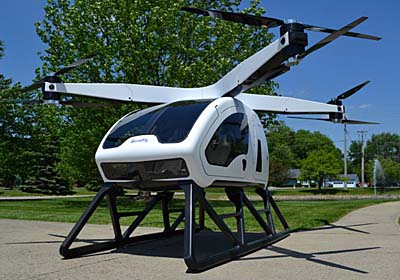 News from the Paris Air Show probably does not interest you too much, unless you care about the airliner you will fly in eight years from now. However, one article caught my interest because of a few references. (The article I found is available
News from the Paris Air Show probably does not interest you too much, unless you care about the airliner you will fly in eight years from now. However, one article caught my interest because of a few references. (The article I found is available 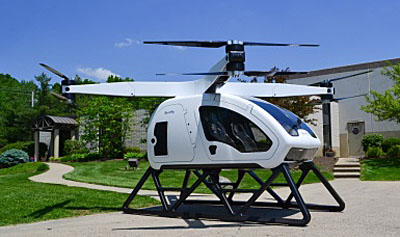 Additionally, SureFly is not on the market yet and when (if?) it does arrive, it might be lots more expensive.
Then, will FAA allow this unusual contraption to fly and where?
So, plenty of questions but I see no escape from the onrush of quadcopter variations and at least this one is piloted; it is not (yet) an autonomously flown aircraft.
Here are a few more points of interest the Workhorse (brand) SureFly (model):
• "SureFly is a personal helicopter/VTOL aircraft, designed to be safer and more stable than a typical helicopter due to its redundant design," said the company. The design includes "four propeller arms, two fixed contra-rotating propellers on each arm, a backup battery to drive the electric motors in the event of engine failure and a ballistic parachute that safely brings down the craft if needed."
• SureFly is designed to fly up to 70 miles at a speed of approximately 70 miles per hour, with an anticipated empty weight of 1,100 pounds and a maximum takeoff weight of 1,500 pounds. This is too heavy for LSA, of course, but not by that much and that's today. Rumors continue to swirl around a weight increase even though such a change is likely years in the future, if ever.
• SureFly is a hybrid design and leverages Workhorse's expertise in manufacturing electric pickup trucks (photo) for the last 10 years. SureFly utilizes the company’s experience with electric propulsion, its extensive use of carbon fiber, and with lithium battery systems.
Additionally, SureFly is not on the market yet and when (if?) it does arrive, it might be lots more expensive.
Then, will FAA allow this unusual contraption to fly and where?
So, plenty of questions but I see no escape from the onrush of quadcopter variations and at least this one is piloted; it is not (yet) an autonomously flown aircraft.
Here are a few more points of interest the Workhorse (brand) SureFly (model):
• "SureFly is a personal helicopter/VTOL aircraft, designed to be safer and more stable than a typical helicopter due to its redundant design," said the company. The design includes "four propeller arms, two fixed contra-rotating propellers on each arm, a backup battery to drive the electric motors in the event of engine failure and a ballistic parachute that safely brings down the craft if needed."
• SureFly is designed to fly up to 70 miles at a speed of approximately 70 miles per hour, with an anticipated empty weight of 1,100 pounds and a maximum takeoff weight of 1,500 pounds. This is too heavy for LSA, of course, but not by that much and that's today. Rumors continue to swirl around a weight increase even though such a change is likely years in the future, if ever.
• SureFly is a hybrid design and leverages Workhorse's expertise in manufacturing electric pickup trucks (photo) for the last 10 years. SureFly utilizes the company’s experience with electric propulsion, its extensive use of carbon fiber, and with lithium battery systems.
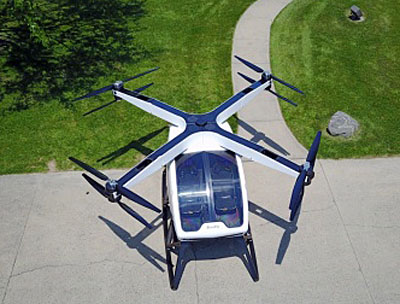 • Early models will be pilot-operated, according to the Vertical magazine article. The goal is to introduce future models featuring autonomous flight capable of carrying payloads of up to 400 pounds. To my view, every developer needs to speak to "autonomous flight" if they want to gain media coverage or raise big buck investments.
• SureFly's controls are said to be minimal, with buttons for up/down altitude adjustment, and a joystick for forward, sideways and yaw. "An on-board computer will automatically adjust throttle to maintain altitude as the aircraft is maneuvered, with speed of travel controlled by how far the joystick is pushed," said the company. That is hardly flying your LSA or ultralight but at least you're not just a passenger.
“We realized we could basically make a big drone, if you will,” Workhorse co-founder and CEO Steve Burns told Vertical magazine. “The battery packs are light, most of our trucks have range extenders, which are gasoline engines that extend the range for when the battery is exhausted, and carbon fiber is in everything we do — so we kind of had the chops to do it.” Burns said SureFly has been in development for about three years.
Workhorse describes the SureFly as a hybrid aircraft, with a gasoline engine driving dual generators that provide power to the eight propeller motors. "With safety top of mind, the aircraft has two backup batteries (each powering four motors) that guarantee five minutes’ flight for an emergency landing should the main power source fail." said Burns. He added that the aircraft will be able to maintain flight on just four propellers, and, if all else fails, SureFly plans a ballistic parachute.
• Early models will be pilot-operated, according to the Vertical magazine article. The goal is to introduce future models featuring autonomous flight capable of carrying payloads of up to 400 pounds. To my view, every developer needs to speak to "autonomous flight" if they want to gain media coverage or raise big buck investments.
• SureFly's controls are said to be minimal, with buttons for up/down altitude adjustment, and a joystick for forward, sideways and yaw. "An on-board computer will automatically adjust throttle to maintain altitude as the aircraft is maneuvered, with speed of travel controlled by how far the joystick is pushed," said the company. That is hardly flying your LSA or ultralight but at least you're not just a passenger.
“We realized we could basically make a big drone, if you will,” Workhorse co-founder and CEO Steve Burns told Vertical magazine. “The battery packs are light, most of our trucks have range extenders, which are gasoline engines that extend the range for when the battery is exhausted, and carbon fiber is in everything we do — so we kind of had the chops to do it.” Burns said SureFly has been in development for about three years.
Workhorse describes the SureFly as a hybrid aircraft, with a gasoline engine driving dual generators that provide power to the eight propeller motors. "With safety top of mind, the aircraft has two backup batteries (each powering four motors) that guarantee five minutes’ flight for an emergency landing should the main power source fail." said Burns. He added that the aircraft will be able to maintain flight on just four propellers, and, if all else fails, SureFly plans a ballistic parachute.
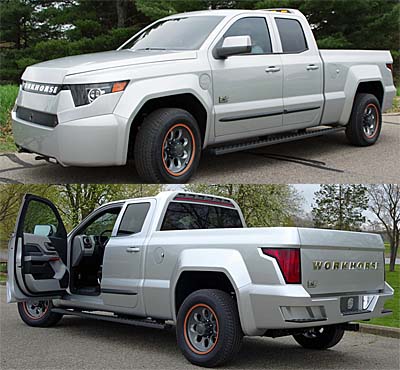
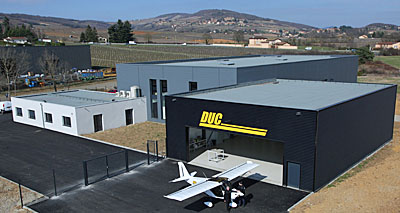
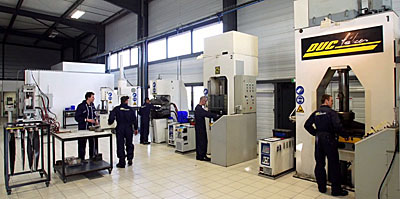 "Lot of guests will arrive all long the day by plane but the party will officially start at 8 p.m. with the visit of the new facilities, a photoBooth on flying topics, a Beaujolais culinary discovery, a cocktail dinner, a music DJ, and some animations throughout the night," said DUC representatives.
"Lot of guests will arrive all long the day by plane but the party will officially start at 8 p.m. with the visit of the new facilities, a photoBooth on flying topics, a Beaujolais culinary discovery, a cocktail dinner, a music DJ, and some animations throughout the night," said DUC representatives.
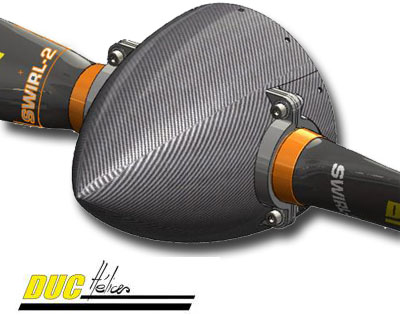 The good news is, DUC props are available in the USA thanks to
The good news is, DUC props are available in the USA thanks to 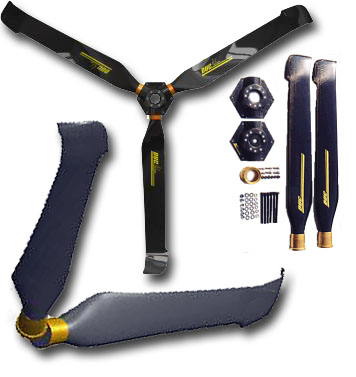 SportairUSA lists some of your choices in props from DUC.
Swirl (photo above) is a simple, ground-adjustable propeller that performs like a complex constant-speed prop. "It is the propeller of choice for faster airplanes," said SportairUSA. How can that be? "Without movement or twisting of the blades DUC's Swirl propeller has a constant speed effect… [because] the prop takes a slimmer bite under load, and a fatter bite when cruising, without the need for complex electro-mechanical adjustments."
Windspoon (lower photo) is for slower aircraft (speeds up to 80 knots for engines up to 120 horsepower). SportairUSA explained, "With its revolutionary shape [that] offers unrivaled performance, Windspoon is the ideal solution for trikes and similar aircraft."
For more detail including specifications and prop ordering information, visit SportairUSA's dedicated
SportairUSA lists some of your choices in props from DUC.
Swirl (photo above) is a simple, ground-adjustable propeller that performs like a complex constant-speed prop. "It is the propeller of choice for faster airplanes," said SportairUSA. How can that be? "Without movement or twisting of the blades DUC's Swirl propeller has a constant speed effect… [because] the prop takes a slimmer bite under load, and a fatter bite when cruising, without the need for complex electro-mechanical adjustments."
Windspoon (lower photo) is for slower aircraft (speeds up to 80 knots for engines up to 120 horsepower). SportairUSA explained, "With its revolutionary shape [that] offers unrivaled performance, Windspoon is the ideal solution for trikes and similar aircraft."
For more detail including specifications and prop ordering information, visit SportairUSA's dedicated 
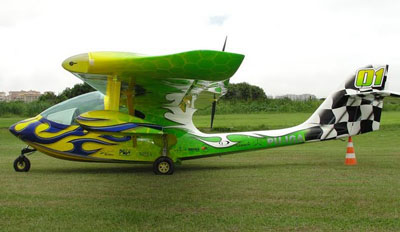 Entering is simple with its widely front-opening canopy; you step on the solid floor and sit. Canopy optics were superb and you have 270-degree visibility thanks to rear quarter windows.
Because you'll want the canopy closed in the water — the airplane sits low — air vents are positioned in the canopy with a second set near your head, tucked away in the wing root area. These keep air flowing inside. When taxiing on land you can leave the canopy open and the hinges are robust; even on a bumpy turf runway, the canopy moves very little.
After rolling off the ramp or beach, you retract the gear in preparation for launch. SeaMax's electromechanical landing gear takes nine second to fully retract. To help you fully prepare, SeaMax offers a digital flap position indicator and digital trim position indicator. You also flip on an electrical fuel boost pump and a relatively uncommon bilge pump prior to moving the throttle forward.
Entering is simple with its widely front-opening canopy; you step on the solid floor and sit. Canopy optics were superb and you have 270-degree visibility thanks to rear quarter windows.
Because you'll want the canopy closed in the water — the airplane sits low — air vents are positioned in the canopy with a second set near your head, tucked away in the wing root area. These keep air flowing inside. When taxiing on land you can leave the canopy open and the hinges are robust; even on a bumpy turf runway, the canopy moves very little.
After rolling off the ramp or beach, you retract the gear in preparation for launch. SeaMax's electromechanical landing gear takes nine second to fully retract. To help you fully prepare, SeaMax offers a digital flap position indicator and digital trim position indicator. You also flip on an electrical fuel boost pump and a relatively uncommon bilge pump prior to moving the throttle forward.
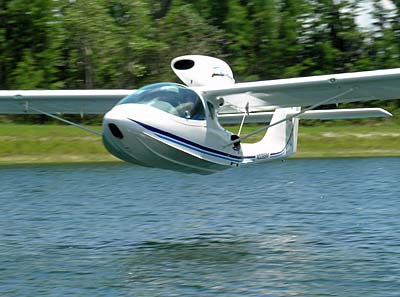 A 100-hp Rotax 912 AirMax moves SeaMax easily on land or water. My experience on the water at 45 mph showed SeaMax to be a great little speedboat. Turning in this configuration employs the water rudder, which extends from inside the air rudder. You use opposite aileron to keep from sticking a sponson too deeply in the water.
On full application of power some water spray may contact the prop so AirMax uses a metal reinforced prop leading edge. As mentioned above cockpit side rails in SeaMax are only inches above the water line. The bottom of occupant seats are below the water line. Until your technique is experienced, I consider this a lake airplane although I heard reports of operations in one-foot waves. Such restrictions are common on smaller amphibians.
My checkout pilot suggested I apply full power with the stick held full aft until breaking water or ground. As the nosewheel lifts, you relax the back pressure and let the plane fly itself off the surface. Rotation occured at about 45 mph indicated on the Dynon instrumentation.
SeaMax’s hull gets on the step in about 100 feet, says AirMax. With continued acceleration takeoff follows in about 300 feet total when flying solo or about 500 feet when flying dual.
A 100-hp Rotax 912 AirMax moves SeaMax easily on land or water. My experience on the water at 45 mph showed SeaMax to be a great little speedboat. Turning in this configuration employs the water rudder, which extends from inside the air rudder. You use opposite aileron to keep from sticking a sponson too deeply in the water.
On full application of power some water spray may contact the prop so AirMax uses a metal reinforced prop leading edge. As mentioned above cockpit side rails in SeaMax are only inches above the water line. The bottom of occupant seats are below the water line. Until your technique is experienced, I consider this a lake airplane although I heard reports of operations in one-foot waves. Such restrictions are common on smaller amphibians.
My checkout pilot suggested I apply full power with the stick held full aft until breaking water or ground. As the nosewheel lifts, you relax the back pressure and let the plane fly itself off the surface. Rotation occured at about 45 mph indicated on the Dynon instrumentation.
SeaMax’s hull gets on the step in about 100 feet, says AirMax. With continued acceleration takeoff follows in about 300 feet total when flying solo or about 500 feet when flying dual.
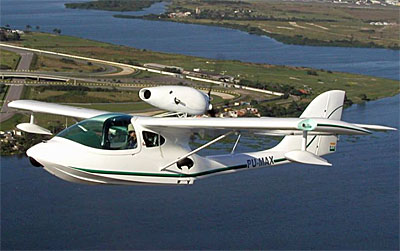 Climbout at 70 mph produced about 1,000 fpm initially. SeaMax sustained climb at about 700 fpm with 10 degrees of flaps.
During landings with full flaps the aircraft approaches at 50 mph. A safe downwind speed is 75-80 mph; this produces about 500 fpm down with the throttle at idle thrust.
Water touchdowns proved very straightforward. SeaMax responds very well as a boat. Touchdown was at about 60 mph and it immediately started tracking true. My check pilots said it is essential to keep the stick full aft to prevent porpoising and possible upset.
Airborne, the SeaMax joystick has a light touch although I recommend a few hours to optimize. My initial efforts at mild dutch rolls were sloppy suggesting handling that takes acclimatization. Rudder control took the most finesse perhaps due to close coupling behind a large cabin combined with a pusher engine. You need to use the rudder but bumps of it rather than steady pressure worked best for me.
Climbout at 70 mph produced about 1,000 fpm initially. SeaMax sustained climb at about 700 fpm with 10 degrees of flaps.
During landings with full flaps the aircraft approaches at 50 mph. A safe downwind speed is 75-80 mph; this produces about 500 fpm down with the throttle at idle thrust.
Water touchdowns proved very straightforward. SeaMax responds very well as a boat. Touchdown was at about 60 mph and it immediately started tracking true. My check pilots said it is essential to keep the stick full aft to prevent porpoising and possible upset.
Airborne, the SeaMax joystick has a light touch although I recommend a few hours to optimize. My initial efforts at mild dutch rolls were sloppy suggesting handling that takes acclimatization. Rudder control took the most finesse perhaps due to close coupling behind a large cabin combined with a pusher engine. You need to use the rudder but bumps of it rather than steady pressure worked best for me.
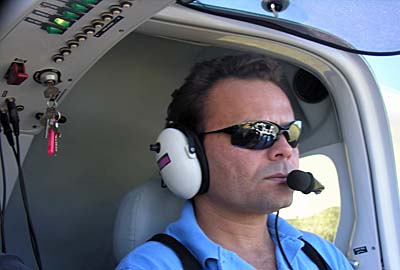
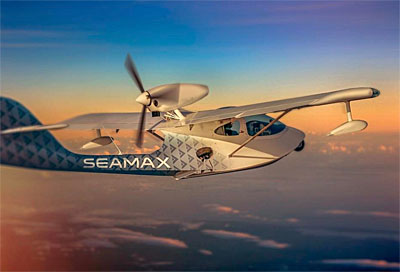 Stalls were mild in my trials. From most entries, stalls appeared to break benignly in the low 40 mph range though the factory says 36 mph with optimal flaps. Longitudinal stability checks and power changes showed SeaMax to be a generally stable aircraft; it recovered from mild disturbances of the stick on its own and with only a few oscillations.
In summary, I'd call SeaMax a "performance LSA seaplane," peppy and demanding a bit more pilot attention but it gets up and goes. Stopped at the airport, pilots checking out SeaMax become impressed quickly.
The following video interview was shot at Sun 'n Fun 2017. For more go to our
Stalls were mild in my trials. From most entries, stalls appeared to break benignly in the low 40 mph range though the factory says 36 mph with optimal flaps. Longitudinal stability checks and power changes showed SeaMax to be a generally stable aircraft; it recovered from mild disturbances of the stick on its own and with only a few oscillations.
In summary, I'd call SeaMax a "performance LSA seaplane," peppy and demanding a bit more pilot attention but it gets up and goes. Stopped at the airport, pilots checking out SeaMax become impressed quickly.
The following video interview was shot at Sun 'n Fun 2017. For more go to our 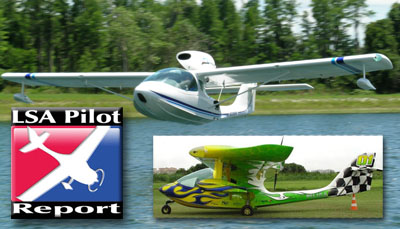
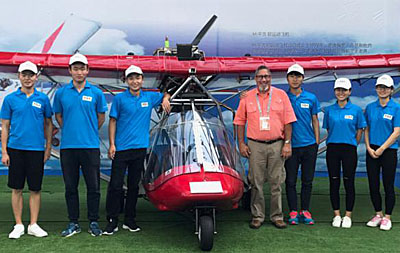
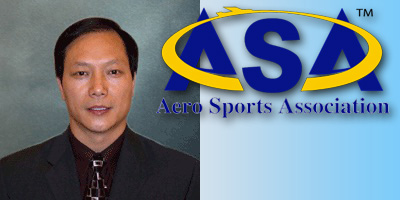
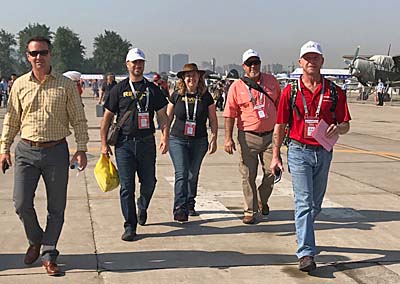

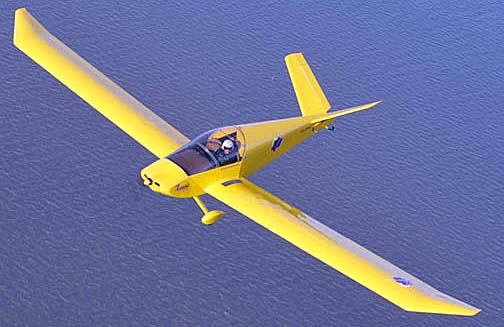 Sonex
Sonex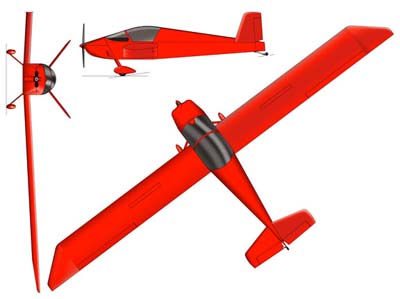 So, I got excited when I read the Sonex Aircraft announce the new Xenos B-Model. You can order a Xenos-B now, kits are shipping, and, earlier purchasers may wish to check out the
So, I got excited when I read the Sonex Aircraft announce the new Xenos B-Model. You can order a Xenos-B now, kits are shipping, and, earlier purchasers may wish to check out the 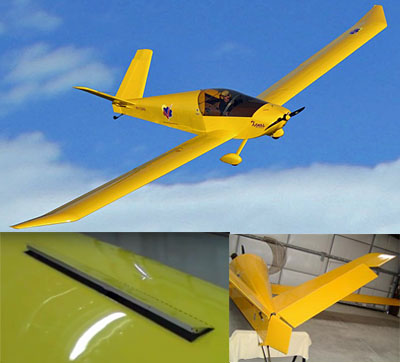

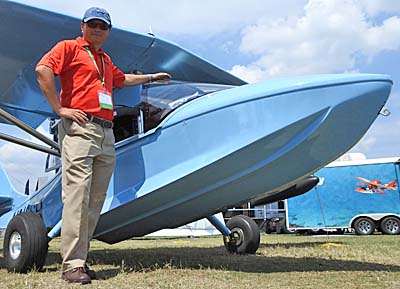 Adam Yang, the CEO of
Adam Yang, the CEO of 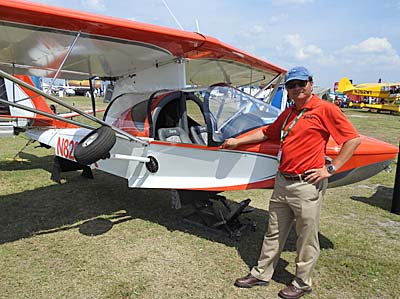 Adam expressed, "I am grateful for all the people who supported the endeavor to make Searey a strong manufacturer of the fun, practical and safe aircraft including employees, customers, contracted professionals, distributors, suppliers, local government officials, pilots, instructors, Searey enthusiasts and their family members. Without everybody’s efforts and selfless support, it would have been absolutely impossible to achieve what we have today."
Adam no longer has an ownership position of Progressive Aerodyne and will take a break before moving on to his next endeavor. However, he added, "I will keep flying the wonderful Searey."
New CEO Nicholson will lead the company to the next level of success. "Geoff has an aerospace engineering degree with years of experience as an executive of operations in the aviation industry," reported Adam. "He holds a commercial rating, multi-engine rating, and was a CFI."
So long, Adam. Best of luck in your new adventures!
Adam expressed, "I am grateful for all the people who supported the endeavor to make Searey a strong manufacturer of the fun, practical and safe aircraft including employees, customers, contracted professionals, distributors, suppliers, local government officials, pilots, instructors, Searey enthusiasts and their family members. Without everybody’s efforts and selfless support, it would have been absolutely impossible to achieve what we have today."
Adam no longer has an ownership position of Progressive Aerodyne and will take a break before moving on to his next endeavor. However, he added, "I will keep flying the wonderful Searey."
New CEO Nicholson will lead the company to the next level of success. "Geoff has an aerospace engineering degree with years of experience as an executive of operations in the aviation industry," reported Adam. "He holds a commercial rating, multi-engine rating, and was a CFI."
So long, Adam. Best of luck in your new adventures!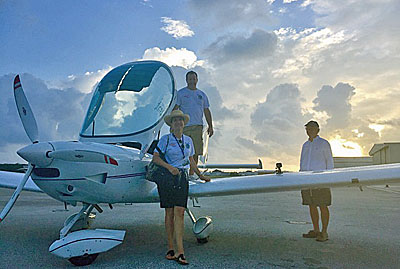 Flying light aircraft to Cuba seems to be a kind of new normal. Whatever the politics of the relations between governments, the fact remains that pilots enjoy using their aircraft and want to fly to interesting destinations. To many, Cuba is one of those places, a reasonably short flight from the USA… albeit over a stretch of mighty ocean.
"Exploring new destinations and sharing the joy of flight are two of the key driving forces behind
Flying light aircraft to Cuba seems to be a kind of new normal. Whatever the politics of the relations between governments, the fact remains that pilots enjoy using their aircraft and want to fly to interesting destinations. To many, Cuba is one of those places, a reasonably short flight from the USA… albeit over a stretch of mighty ocean.
"Exploring new destinations and sharing the joy of flight are two of the key driving forces behind 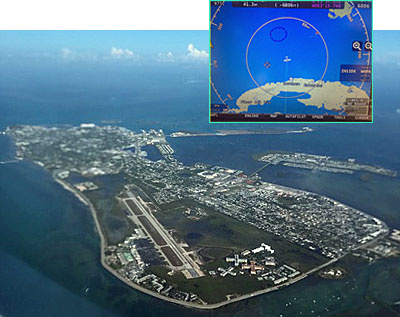 Starinsky and Schrade saw the rally as an opportunity to forge new relationships and take the first steps in revitalizing the once vibrant general aviation community in Cuba. They also sought to commemorate the first aviators to make the crossing from the Florida Keys to Cuba. "Rivals Domingo Rosillo del Toro and Augustin Parla accomplished the feat of the longest flights over water in May 1913," said Cruiser Aircraft.
"Flying in SportCruiser N767SX, Starinsky and Schrade were joined by Cruiser team members Bob Harris and Erin Porter in SportCruiser N707SX," noted the company. The four set out from the company’s current base at North Perry Airport Thursday, May 18, flying to Marathon (KMTH) to gather with other VFR pilot participants along with International Air Rally organizers Catherine Tobenas and Camile Dumont. The pair gave a detailed briefing.
"After filing a very specific flight plan and learning the intricacies of the specially designated military corridor to be flown by the seven aircraft in the rally, spaced five minutes apart, the group launched on the morning of May 19, 104 years and two days after del Toro’s first successful crossing," said Cruiser Aircraft.
Starinsky and Schrade saw the rally as an opportunity to forge new relationships and take the first steps in revitalizing the once vibrant general aviation community in Cuba. They also sought to commemorate the first aviators to make the crossing from the Florida Keys to Cuba. "Rivals Domingo Rosillo del Toro and Augustin Parla accomplished the feat of the longest flights over water in May 1913," said Cruiser Aircraft.
"Flying in SportCruiser N767SX, Starinsky and Schrade were joined by Cruiser team members Bob Harris and Erin Porter in SportCruiser N707SX," noted the company. The four set out from the company’s current base at North Perry Airport Thursday, May 18, flying to Marathon (KMTH) to gather with other VFR pilot participants along with International Air Rally organizers Catherine Tobenas and Camile Dumont. The pair gave a detailed briefing.
"After filing a very specific flight plan and learning the intricacies of the specially designated military corridor to be flown by the seven aircraft in the rally, spaced five minutes apart, the group launched on the morning of May 19, 104 years and two days after del Toro’s first successful crossing," said Cruiser Aircraft.
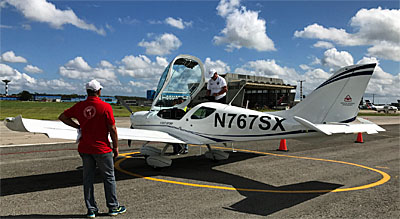 Like del Toro and Parla, the Cruiser team faced unfamiliar and possibly treacherous circumstances. This was a new experience for the pilots.
"Deviating in any way from the flight plan was strictly forbidden." said the company. "The pilots were sternly instructed to follow predefined waypoints before finally reaching MUHA in Havana."
Like del Toro and Parla, the Cruiser team faced unfamiliar and possibly treacherous circumstances. This was a new experience for the pilots.
"Deviating in any way from the flight plan was strictly forbidden." said the company. "The pilots were sternly instructed to follow predefined waypoints before finally reaching MUHA in Havana."
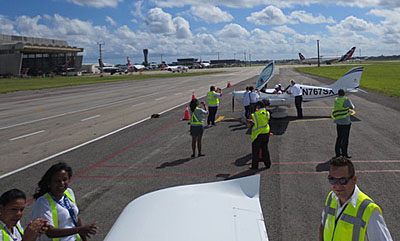 After a three-day visit in Havana, the Cruiser team returned to Florida clearing customs at KEYW before returning home to North Perry Monday on May 22.
"The annual VFR Air Rally to Cuba is just one of the special experiences Cruiser Aircraft Inc. intends to bring to the SportCruiser community when it opens its new facility in Sebastian, Florida this summer," said Cruiser Aircraft. The company said their "Cruiser Club will allow SportCruiser owners to experience exciting destinations around the world in SportCruiser aircraft." For more information visit www.cruiseraircraft.com.
Cruiser Aircraft Inc. is currently based at North Perry Airport in the Miami area but reported plans to work on establishing a new headquarters at Sebastian Municipal Airport to be operational summer 2017.
After a three-day visit in Havana, the Cruiser team returned to Florida clearing customs at KEYW before returning home to North Perry Monday on May 22.
"The annual VFR Air Rally to Cuba is just one of the special experiences Cruiser Aircraft Inc. intends to bring to the SportCruiser community when it opens its new facility in Sebastian, Florida this summer," said Cruiser Aircraft. The company said their "Cruiser Club will allow SportCruiser owners to experience exciting destinations around the world in SportCruiser aircraft." For more information visit www.cruiseraircraft.com.
Cruiser Aircraft Inc. is currently based at North Perry Airport in the Miami area but reported plans to work on establishing a new headquarters at Sebastian Municipal Airport to be operational summer 2017.
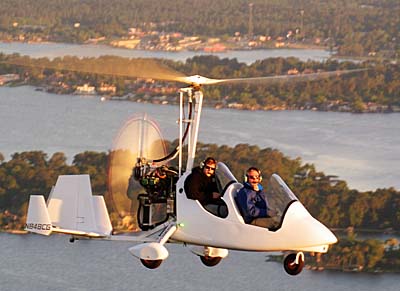

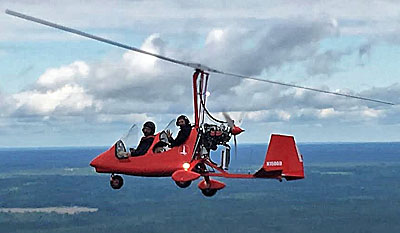

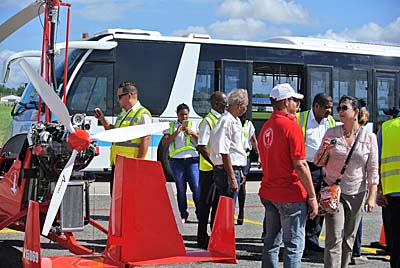

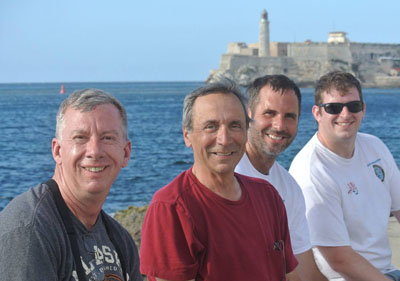
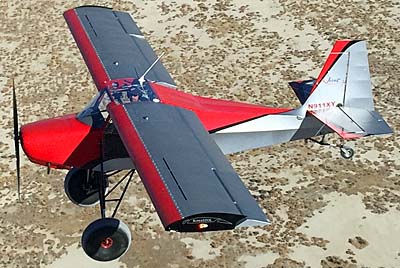 Both these companies are to be congratulated for advancing the light aircraft field, but one aircraft really lit this space on fire:
Both these companies are to be congratulated for advancing the light aircraft field, but one aircraft really lit this space on fire: 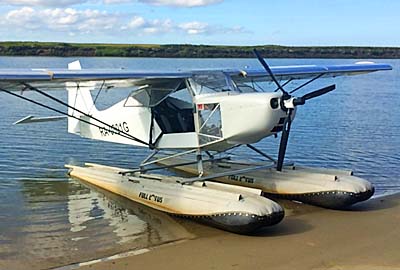 Thanks to those flight qualities, one was pressed into scientific survey service in a difficult environment. Russian biologists sought an aircraft to conduct surveys of wildlife populations along the Northeastern Russian Coast, above the Arctic Circle. George V. Kirtaev ordered a SuperSTOL kit from Just Aircraft in the summer of 2015. Russia allows homebuilts to be constructed, certified and flown in their airspace.
With more than 200 hours in his SuperSTOL, Kirtaev said, “It is possible to fly low and slow which is essential for counting and photography.” The rugged design has proved to be good working aircraft. “There is a lot of space inside for gear and you can even spend the night in it," added Kirtaev.
Complementing the hardworking wing Troy created a landing gear system that takes full advantage of a hydraulic strut with a surprising long stroke travel. SuperSTOL's tail wheel also incorporates a hydraulic shock to lessen aggressive off-airport landings. You can read my experience with SuperSTOL and this amazing landing gear
Thanks to those flight qualities, one was pressed into scientific survey service in a difficult environment. Russian biologists sought an aircraft to conduct surveys of wildlife populations along the Northeastern Russian Coast, above the Arctic Circle. George V. Kirtaev ordered a SuperSTOL kit from Just Aircraft in the summer of 2015. Russia allows homebuilts to be constructed, certified and flown in their airspace.
With more than 200 hours in his SuperSTOL, Kirtaev said, “It is possible to fly low and slow which is essential for counting and photography.” The rugged design has proved to be good working aircraft. “There is a lot of space inside for gear and you can even spend the night in it," added Kirtaev.
Complementing the hardworking wing Troy created a landing gear system that takes full advantage of a hydraulic strut with a surprising long stroke travel. SuperSTOL's tail wheel also incorporates a hydraulic shock to lessen aggressive off-airport landings. You can read my experience with SuperSTOL and this amazing landing gear 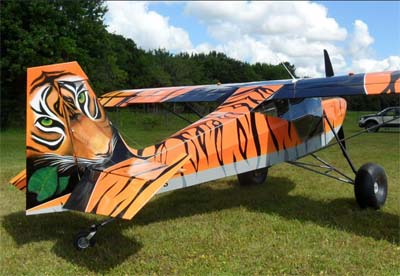 Wing slats combined with large surface area Fowler flaps allow the aircraft to be flown at extremely high angles of attack, permitting it to drop into small or inclined clearings. This provides access to considerably more off-airport landing sites, making the SuperStol one of the most versatile backcountry machines available. With the new wing configuration, Just Aircraft said the aircraft can cruise at 110 mph, land at 32 mph, and take off or land with as little as 150 feet of runway …or maybe a lot less.
Alaska pilot Robby Pedersen won first place in the LSA Class at the Valdez short landing and take off competition. He was aided in this task by
Wing slats combined with large surface area Fowler flaps allow the aircraft to be flown at extremely high angles of attack, permitting it to drop into small or inclined clearings. This provides access to considerably more off-airport landing sites, making the SuperStol one of the most versatile backcountry machines available. With the new wing configuration, Just Aircraft said the aircraft can cruise at 110 mph, land at 32 mph, and take off or land with as little as 150 feet of runway …or maybe a lot less.
Alaska pilot Robby Pedersen won first place in the LSA Class at the Valdez short landing and take off competition. He was aided in this task by 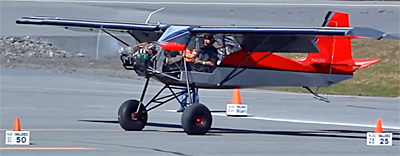 Just Aircraft offers several SuperSTOL engine options including the original
Just Aircraft offers several SuperSTOL engine options including the original 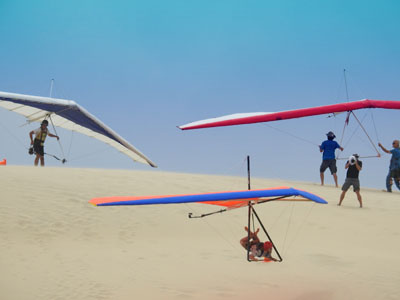 Wind blows across the dunes here in Nags Head in a way that first drew the Wright Brothers 114 years ago. Indeed, a couple miles north a memorial commemorates the famous bicycle shop owners who made history in this breezy outpost on the Outer Banks of North Carolina.
For 45 years, an event has occurred on these ever-shifting dunes qualifying it as one of aviation's longest-lasting events. To some eyes, it may also be one of the most fun, a nearly innocent way to take to the air in the lightest of wings. Many do it barefoot, and here, that's perfectly fine.
This is the grandly-named
Wind blows across the dunes here in Nags Head in a way that first drew the Wright Brothers 114 years ago. Indeed, a couple miles north a memorial commemorates the famous bicycle shop owners who made history in this breezy outpost on the Outer Banks of North Carolina.
For 45 years, an event has occurred on these ever-shifting dunes qualifying it as one of aviation's longest-lasting events. To some eyes, it may also be one of the most fun, a nearly innocent way to take to the air in the lightest of wings. Many do it barefoot, and here, that's perfectly fine.
This is the grandly-named 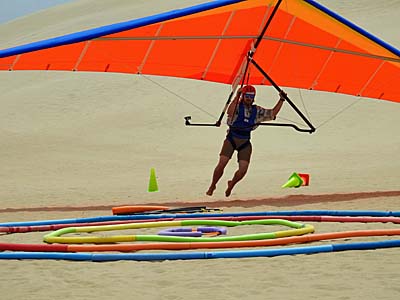 Fun abounds and no wonder. "Spec" is sponsored by Kitty Hawk Kites supported by other local businesses. Kitty Hawk — Nags Head — the Outer Banks… this is a major tourist haven. Mile upon mile of beach houses are rented to millions of tourists from all over the east cost.
All those folks are looking for some fun on their vacation and Kitty Hawk Kites owner John Harris' multiple businesses give many ways to enjoy the area. His hang gliding school, established in 1974 has probably trained more hang glider pilots than any other school on Earth. Many went on to fly airliners and other working aircraft. Another large bunch of them still enjoy this simple and inexpensive way to go aloft.
Not all hang gliding is sand dune flying, of course. Impressive flights of many hundreds of miles have been achieved and competitions occur around the world showcasing truly expert pilots using high-tech gliders and gear. However, nearly all these "sky gods" learned to fly in a manner similar to what happens here at Kitty Hawk Kites.
Fun abounds and no wonder. "Spec" is sponsored by Kitty Hawk Kites supported by other local businesses. Kitty Hawk — Nags Head — the Outer Banks… this is a major tourist haven. Mile upon mile of beach houses are rented to millions of tourists from all over the east cost.
All those folks are looking for some fun on their vacation and Kitty Hawk Kites owner John Harris' multiple businesses give many ways to enjoy the area. His hang gliding school, established in 1974 has probably trained more hang glider pilots than any other school on Earth. Many went on to fly airliners and other working aircraft. Another large bunch of them still enjoy this simple and inexpensive way to go aloft.
Not all hang gliding is sand dune flying, of course. Impressive flights of many hundreds of miles have been achieved and competitions occur around the world showcasing truly expert pilots using high-tech gliders and gear. However, nearly all these "sky gods" learned to fly in a manner similar to what happens here at Kitty Hawk Kites.
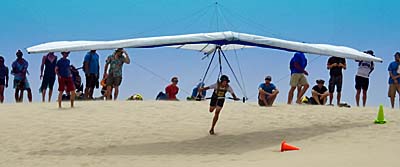 Powered aircraft pilot might not think this appeals to them. That's understandable. Yet those of us who spent years in hang gliding can attest to the good times this kind of flying provides. More than any other aircraft, a hang glider comes closest to delivering the childhood fantasy of your arms as wings. Angels of the sky? Maybe, but if you fly, you know the enjoyment going aloft can bring; sand dune hang gliding is another fine way to enjoy the air.
This short video produced at the 2016 event gives a flavor of the festivities and gives an up close glimpse at the dune flying.
https://youtu.be/b307YiBpxhE
Powered aircraft pilot might not think this appeals to them. That's understandable. Yet those of us who spent years in hang gliding can attest to the good times this kind of flying provides. More than any other aircraft, a hang glider comes closest to delivering the childhood fantasy of your arms as wings. Angels of the sky? Maybe, but if you fly, you know the enjoyment going aloft can bring; sand dune hang gliding is another fine way to enjoy the air.
This short video produced at the 2016 event gives a flavor of the festivities and gives an up close glimpse at the dune flying.
https://youtu.be/b307YiBpxhE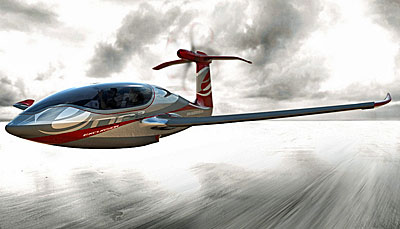 Now consider Equator Aircraft P2 Xcursion, an electric hybrid seaplane with several compelling ideas. I wrote about this in
Now consider Equator Aircraft P2 Xcursion, an electric hybrid seaplane with several compelling ideas. I wrote about this in 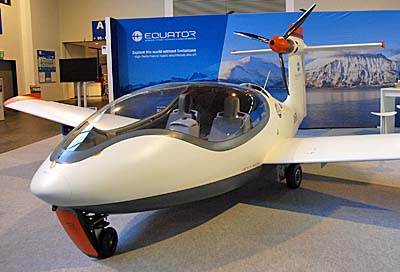
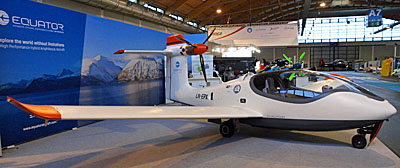

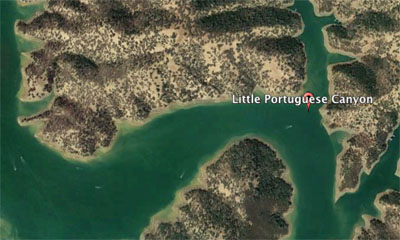

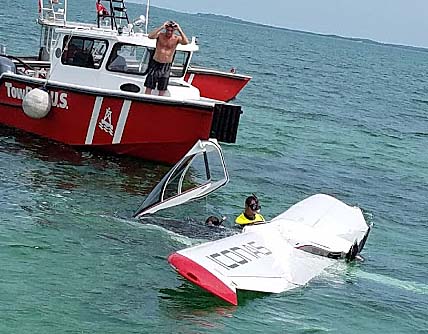
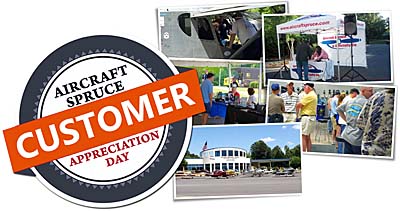 Does any aviator in the country not know the name
Does any aviator in the country not know the name  "This is the time of year when we go all out by offering spectacular discounts on our most popular products and provide a chance for our loyal customers to meet our vendors," said Aircraft Spruce representatives. You might even win a free AvMap Engibox.
Those looking for expert advice will find it as Aircraft Spruce brings in representatives from many leading aviation products to demonstrate and discuss the benefits of their products.
Additionally, the Falcon RV Squadron is hosting their spring 2017 RV fly-in and cookout on the same day as the CAD event. If you have, or are interested in building, an RV aircraft they invite you to join the party. EAA will coordinate with Aircraft Spruce to provide a couple of their well-regarded, hands-on workshops so if you're working on an RV-12 (or any RV model),
"This is the time of year when we go all out by offering spectacular discounts on our most popular products and provide a chance for our loyal customers to meet our vendors," said Aircraft Spruce representatives. You might even win a free AvMap Engibox.
Those looking for expert advice will find it as Aircraft Spruce brings in representatives from many leading aviation products to demonstrate and discuss the benefits of their products.
Additionally, the Falcon RV Squadron is hosting their spring 2017 RV fly-in and cookout on the same day as the CAD event. If you have, or are interested in building, an RV aircraft they invite you to join the party. EAA will coordinate with Aircraft Spruce to provide a couple of their well-regarded, hands-on workshops so if you're working on an RV-12 (or any RV model), 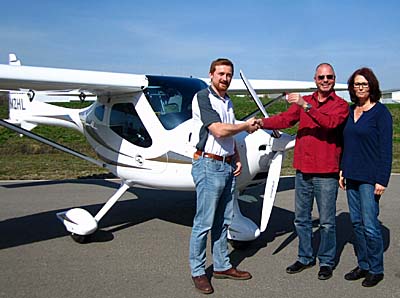
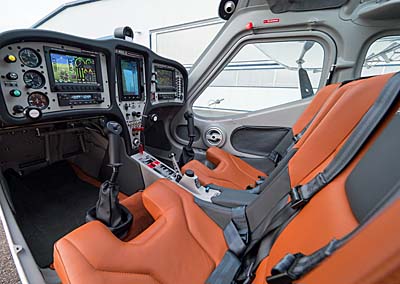
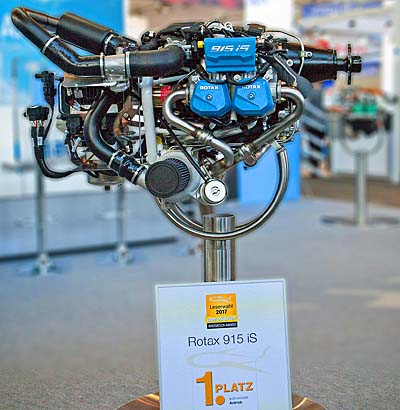 Rotax Aircraft Engines
Rotax Aircraft Engines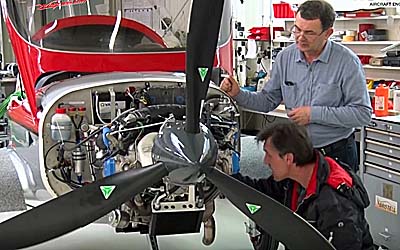
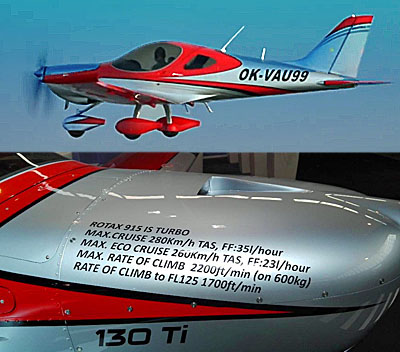 BRM has been flying a prototype aircraft with the 915 iS engine installed. Their preliminary flying shows some solid results.
BRM has been flying a prototype aircraft with the 915 iS engine installed. Their preliminary flying shows some solid results.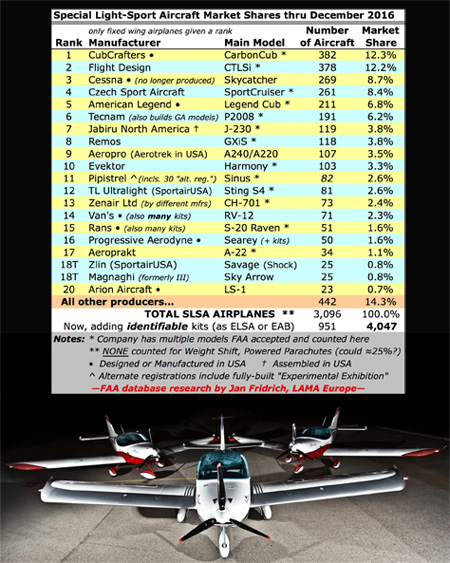
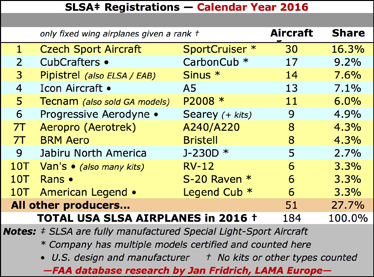


 Mainstream media outfits exploded with news of Google's flying car. Although such news outlets rarely seem to notice recreational aviation other than when an accident occurs, the reports I read did a respectable job of covering flying car projects we already knew about (reported
Mainstream media outfits exploded with news of Google's flying car. Although such news outlets rarely seem to notice recreational aviation other than when an accident occurs, the reports I read did a respectable job of covering flying car projects we already knew about (reported 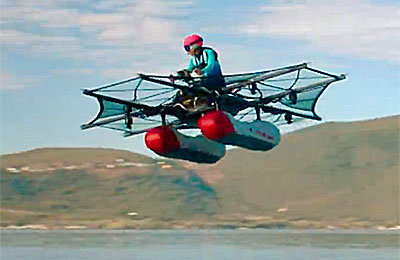 Funded by Google founder, Larry Page — an uber rich tech personality — Kitty Hawk is not simply an exploratory project. They actually plan to sell this cool little rig. Flyer is an open-seated, 220-pound empty weight octocopter with seat (saddle?) for one person. Powered by eight battery-powered propellers, it is a man-carrying drone for sport flying.
Funded by Google founder, Larry Page — an uber rich tech personality — Kitty Hawk is not simply an exploratory project. They actually plan to sell this cool little rig. Flyer is an open-seated, 220-pound empty weight octocopter with seat (saddle?) for one person. Powered by eight battery-powered propellers, it is a man-carrying drone for sport flying.
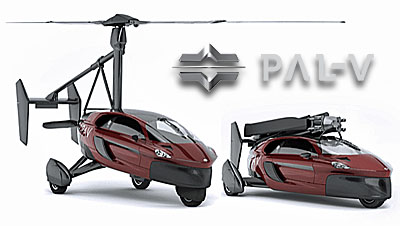
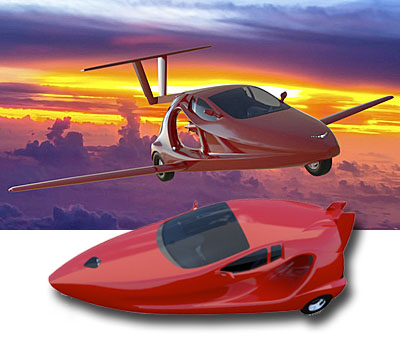
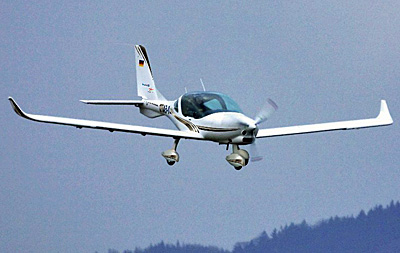
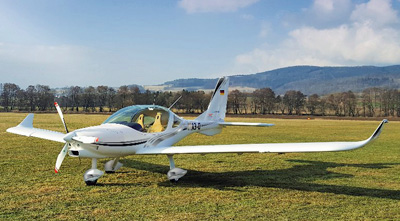 “Vessel CEO was present for the ground testing and first flight of the KLA-100,” said Mr. Kiman Seo, CEO of Vessel Co., Ltd. “Vessel is running a parallel development and flight test program in South Korea to gather as much experience for certification in Korea.”
KLA-100 wing is a modern aeronautical design using Flight Design's extensive experience at designing and building Light-Sport Aircraft or European microlights. A high aspect ratio wing planform is used to reduce drag and increase climb, a new proprietary airfoil has an improved coefficient of lift and reduced drag through a greater percentage of laminar flow. The Stall-Safe drooped leading edge (see cuff in photos) is designed to keep the airflow attached at the tips, promote post-stall aileron control and resist spins.
“Vessel CEO was present for the ground testing and first flight of the KLA-100,” said Mr. Kiman Seo, CEO of Vessel Co., Ltd. “Vessel is running a parallel development and flight test program in South Korea to gather as much experience for certification in Korea.”
KLA-100 wing is a modern aeronautical design using Flight Design's extensive experience at designing and building Light-Sport Aircraft or European microlights. A high aspect ratio wing planform is used to reduce drag and increase climb, a new proprietary airfoil has an improved coefficient of lift and reduced drag through a greater percentage of laminar flow. The Stall-Safe drooped leading edge (see cuff in photos) is designed to keep the airflow attached at the tips, promote post-stall aileron control and resist spins.
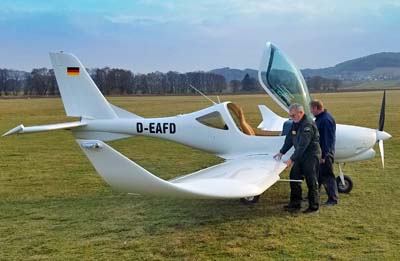 KLA-100 is powered by 100 horsepower (74 KW) from a fuel injected
KLA-100 is powered by 100 horsepower (74 KW) from a fuel injected